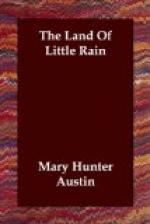For two summers a great red-tailed hawk has visited the field every afternoon between three and four o’clock, swooping and soaring with the airs of a gentleman adventurer. What he finds there is chiefly conjectured, so secretive are the little people of Naboth’s field. Only when leaves fall and the light is low and slant, one sees the long clean flanks of the jackrabbits, leaping like small deer, and of late afternoons little cotton-tails scamper in the runways. But the most one sees of the burrowers, gophers, and mice is the fresh earthwork of their newly opened doors, or the pitiful small shreds the butcher-bird hangs on spiny shrubs.
It is a still field, this of my neighbor’s, though so busy, and admirably compounded for variety and pleasantness,—a little sand, a little loam, a grassy plot, a stony rise or two, a full brown stream, a little touch of humanness, a footpath trodden out by moccasins. Naboth expects to make town lots of it and his fortune in one and the same day; but when I take the trail to talk with old Seyavi at the campoodie, it occurs to me that though the field may serve a good turn in those days it will hardly be happier. No, certainly not happier.
THE MESA TRAIL
The mesa trail begins in the campoodie at the corner of Naboth’s field, though one may drop into it from the wood road toward the canon, or from any of the cattle paths that go up along the streamside; a clean, pale, smooth-trodden way between spiny shrubs, comfortably wide for a horse or an Indian. It begins, I say, at the campoodie, and goes on toward the twilight hills and the borders of Shoshone Land. It strikes diagonally across the foot of the hill-slope from the field until it reaches the larkspur level, and holds south along the front of Oppapago, having the high ranges to the right and the foothills and the great Bitter Lake below it on the left. The mesa holds very level here, cut across at intervals by the deep washes of dwindling streams, and its treeless spaces uncramp the soul.
Mesa trails were meant to be traveled on horseback, at the jigging coyote trot that only western-bred horses learn successfully. A foot-pace carries one too slowly past the units in a decorative scheme that is on a scale with the country round for bigness. It takes days’ journeys to give a note of variety to the country of the social shrubs. These chiefly clothe the benches and eastern foot-slopes of the




